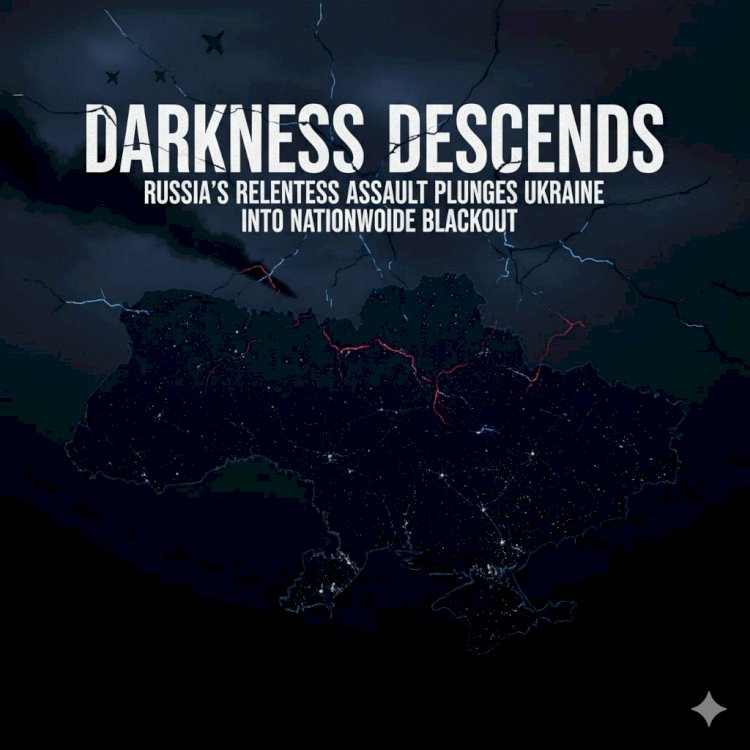Darkness Descends: Russia's Relentless Assault Plunges Ukraine into Nationwide Blackout

Kyiv, Ukraine – November 9, 2025 – In the dead of night, as temperatures dipped toward winter's bite, Russia unleashed one of its most ferocious barrages yet on Ukraine's fragile energy grid. By dawn, millions awoke to a chilling reality: lights out, heaters silent, and water pumps stalled across nearly every corner of the country. The massive assault – a storm of over 45 ballistic missiles and 450 drones – has shattered key power plants and substations, forcing emergency blackouts that could stretch up to 18 hours daily. As repair crews scramble amid the rubble, Ukrainians brace for a grueling season where survival hinges on flickering generators and unyielding resolve.
Missile Monsoon: The Anatomy of a Grid-Killing Onslaught
The attack, which began late Friday and raged into Saturday, marked the fifth major strike on Ukraine's energy infrastructure since October. Russian forces zeroed in on thermal power plants feeding Kyiv and Kharkiv, along with substations linked to nuclear facilities in Khmelnytskyi and Rivne. Centrenergo, the state-owned energy giant, reported a complete shutdown of all its thermal plants, wiping out generation capacity and sending ripples of failure through the national network. Ukrainian air defenses, stretched thin, intercepted just nine missiles and hundreds of drones, but the damage was done: fires erupted in Poltava, transformers exploded in Odesa, and at least seven lives were claimed in Dnipro and beyond.
Energy Minister Svitlana Hrynchuk called it "one of the largest direct ballistic attacks" since the war's outset, a calculated bid to freeze Ukraine into submission before the first snows. With over 25 locations hit, the grid's generating capacity has plummeted to near zero in affected zones, triggering automated safeguards that plunged entire cities into darkness. From the neon haze of Kyiv's metro – now idled by voltage drops – to the shadowed streets of Kharkiv, where water and heating faltered, the human cost mounts in quiet desperation.
Blackout Blues: Daily Life Ground to a Halt in the Heart of Winter Prep
Imagine planning your day around the hum of a diesel generator, or huddling by candlelight as children pore over homework by flashlight. That's the new normal for Ukrainians, where hourly outage schedules – now ballooning to 16 hours in hotspots like Dnipropetrovsk and Sumy – dictate everything from cooking meals to charging phones. In Vinnytsia, far from the front lines, residents endure just 3-6 hours of power daily, a far cry from the pre-war glow. Elderly folks shun elevators, families cluster in cafes with backup batteries, and hospitals lean on reserves that won't last the season.
The ripple effects are merciless: disrupted water supplies in Poltava force boil advisories, while Kharkiv's trams and buses reroute around dead zones. Public transport grinds slower, borders snarl with system failures, and even President Volodymyr Zelenskyy filmed his defiant address by smartphone in a powerless office. As autumn chills deepen, experts warn of a "heating apocalypse" – without swift repairs, homes could go cold, amplifying the toll on the vulnerable.
Retaliation's Echo: Ukraine Strikes Back at the Kremlin's Power Pillars
Ukraine didn't sit idle in the shadows. In a tit-for-tat that underscores the war's escalating energy duel, Kyiv's drones hammered Russian facilities overnight, scorching a thermal plant in Voronezh and a substation in Volgograd. Russian governors downplayed the hits, claiming quick restorations, but the message was clear: Ukraine's long-range capabilities can reach deep, mirroring Moscow's playbook. This shadow war on infrastructure – Russia targeting grids to sow chaos, Ukraine hitting refineries to starve fuel lines – has become the conflict's brutal underbelly, with both sides betting on blackouts to break spirits.
As IAEA teams race to secure nuclear sites like Zaporizhzhia, now reconnected to backup lines after months of peril, the fragility of the system hangs like a sword. Ukraine's grid, already scarred by prior assaults that erased 60% of gas production, teeters on technical default, per experts. Without billions in aid, the lights may stay dim through 2026.
Zelenskyy's Fury: Demands for Sanctions to Starve the Russian War Machine
From his makeshift command post, Zelenskyy lashed out at the "barbaric" strikes, urging the West to unleash full-throated sanctions on Russia's untouched nuclear sector, oil trade, and microelectronics supply chains. "For every energy strike that hurts civilians before winter, there must be a response on the entire Russian energy sector," he thundered, his words a rallying cry amid the gloom. Allies have pledged transformers and generators, but Kyiv insists on bolder strokes – carbon taxes on Russian exports, perhaps, or frozen assets funneled to rebuild.
Critics in Moscow frame the attacks as "defensive," yet the pattern screams strategy: cripple the economy, demoralize the populace, force a fold. As Trump-era aid uncertainties loom, Ukraine's plea grows urgent – not just for weapons, but for the wattage to keep the fight alive.
Flickering Hope: Repairs Race Against the Winter Witch
Amid the outages, glimmers persist. Ukrenergo vows hourly rotations starting tomorrow to ease the strain, while international crews – shielded by fragile ceasefires – mend lines at Zaporizhzhia. Cities have fortified hospitals and shelters with solar backups, a testament to ingenuity forged in fire. Youth in Kyiv share memes of pets in blackout costumes, a spark of defiance against the dark.
Yet as November's frost creeps in, the stakes soar. Will repairs outpace the cold? Can sanctions blunt Russia's blade? Ukraine's blackout is more than a power failure – it's a test of endurance, where every restored bulb symbolizes unbowed will. In the pitch black, one truth endures: the lights may dim, but the resistance burns brighter.

 content-team
content-team 
















